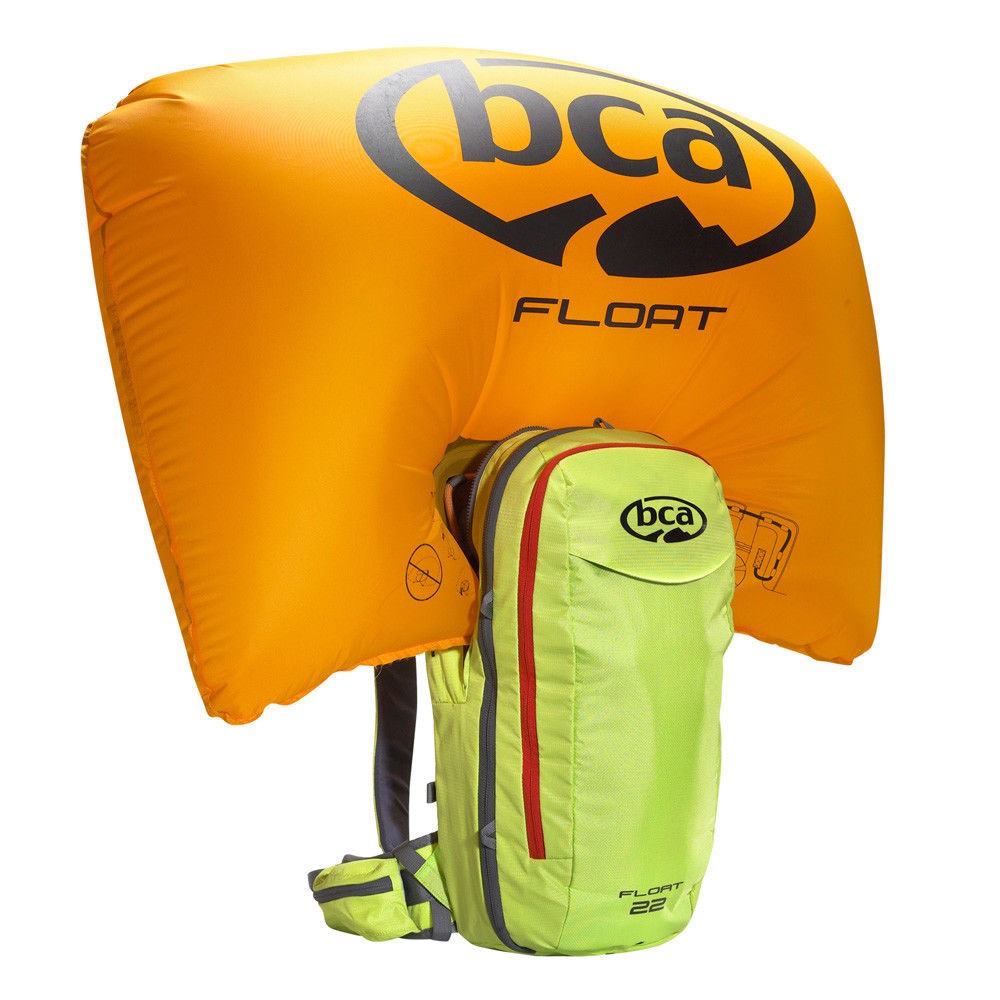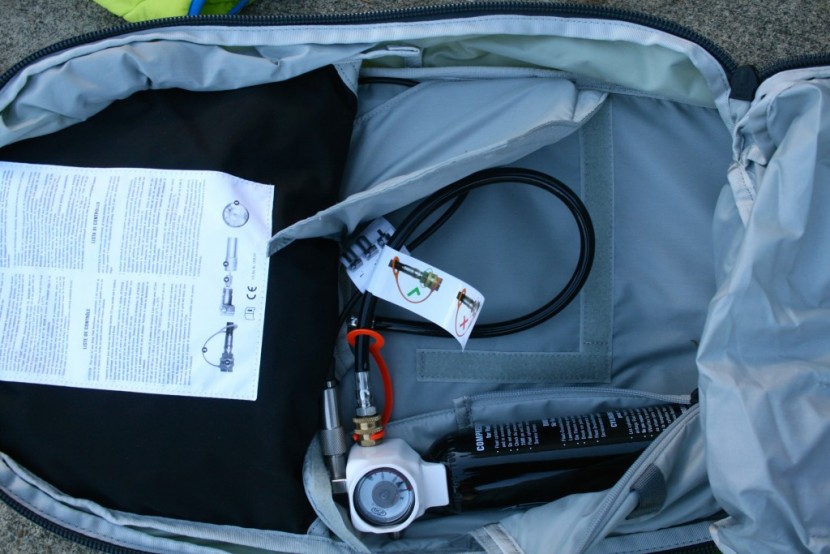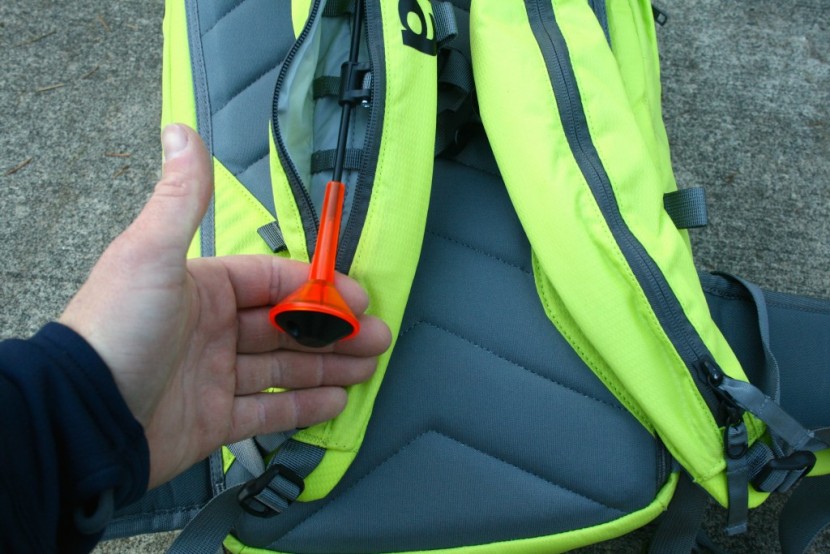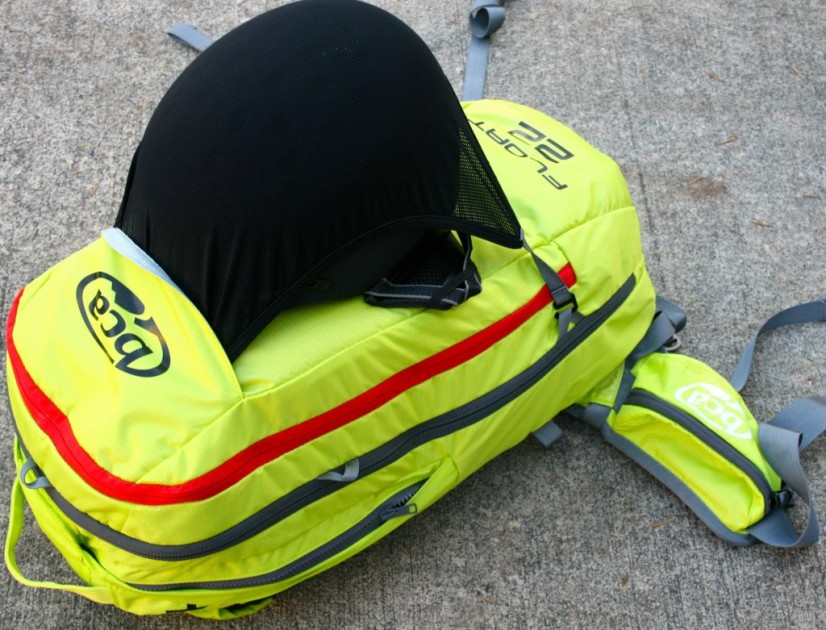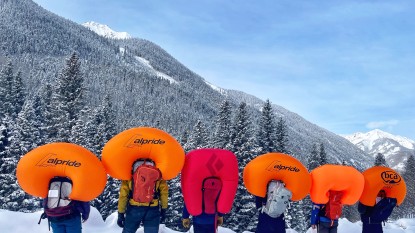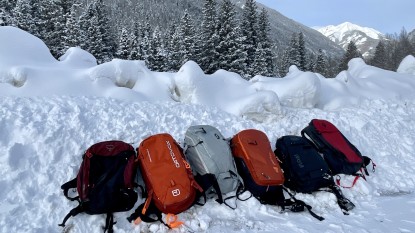The Float 22 excels at mechanized (heli, side-country, etc.) skiing and snowboarding but still functions well for day touring - as long as not too much technical gear is needed (AKA: rope, harness etc), whereas the Float 32 is primarily an all day touring, ski mountaineering, and light hut-to-hut pack. The Float 22 is reasonably lightweight and is one of the best-priced airbags in our review. The BCA packs don't have as fancy, unique, or as modular of an airbag system, but they remain extremely functional, dependable, and are among the least expensive.
Backcountry Access Float 22 Review
Our Verdict
Our Analysis and Test Results
Hands-On Review
Airbag System
This pack, like its bigger cousin the Float 32, uses compressed air to inflate a single 150L bag. The BCA airbag deploys from the top of the pack above your head to increase the odds that you will be on top of the debris when the avalanche comes to a stop. The location of the airbag also increases the odds of the wearer coming to a stop in a heads up position, decreasing the rescue time required to get to your airway.
The airbag itself used in BCA systems is one of the more basic, offering what is becoming the standard shape. It doesn't offer anything special or unique, but it is reliable and performs its most important task of keeping the wearer on the surface. The BCA system, like Mammut and Snowpulse systems, use compressed air. On the Float packs, the airbag system is removable and therefore interchangeable, but at this point, there is only one model of Float pack that is sold without the airbag system (and that's the Float 8).
Refilling Options
Backcountry Access employs compressed air canisters across all Float packs. Compressed nitrogen beats the performance of compressed air by a small margin, but compressed air is cheaper and easier to refill. Ask local diving, paintball, or outdoor rec gear stores if they will refill your canister. If you have any tools or setup that uses compressed air, BCA sells an adapter you can purchase to refill your cartridges. It is possible to refill BCA canisters by hand if you are traveling to super remote regions by using a Benjamin high-pressure Pump which is capable of refilling the cylinder to the prerequisite 2700 PSI.
Trigger Mechanism
The new Float 22, unlike the older version, allows the trigger to be worn inside either shoulder strap. The Float 22 also features four horizontal webbing loops inside the shoulder strap compartment to allow the wearer to customize the height of the trigger, further making it easier to grab. The BCA trigger mechanism is a basic, but reliable system with its only nuance being that you need to spend thirty seconds to one minute double checking the internally threaded connection (where the trigger attaches to the canister) to make sure it hasn't come unthreaded - which it can over long periods of time. We don't think this is a big deal, as you should be doing something similar with all airbag packs.
Travel Considerations
When flying domestically in the United States, you can fly with an empty compressed air canister as long as it's in your checked baggage. Internationally, it is currently okay to fly with a full cartridge and we have done this a half dozen times on flights to Europe to verify that it actually works.
Backcountry Utility
Our testers love the overall layout of this airbag and BCA upgraded our testers' biggest gripe with the old version when designing the new Float 22. It now features a longer and larger snow safety gear pocket that accommodates most average sized probes, saws, and shovels.
Other high scorers in our fleet for the backcountry utility metric include the Arc'teryx Voltair 30, Backcountry Access Float 32, and Backcountry Access Float 42; each of these contenders scored a perfect 10 out of 10.
Carrying Skis/Snowboard
Carring skis A-frame style is a challenge. However it's the easiest pack to carry skis diagonally. Set up is fast and “ski flop n' roll” is limited. The option snowboard-carrying accessory will run you $35. However, it carries the board horizontally: ok if snowmobiling but not ideal if snowboard mountaineering.
Features
This contender also features a mesh, permanently attached helmet carrier that can function in the middle of the pack, or can be offset to one side to keep your helmet out of the way while carrying skis diagonally.
The Float 22 features a single, large zippered hip belt pocket that is great for ski straps, a couple (yes a couple) Snickers bars, an Inclinometer, or a traditional point and shoot camera. We loved being able to keep a camera in the pocket for quick shots. The Float 22 also features an internal mesh pocket for smaller, easily lost items.
Comfort
The Float 22 runs slightly shorter than the Float 32. The Float 22 is comfortable and carries well while skiing and skinning. The only downside is it only comes in one size, limiting the number of people it might fit. The shoulder straps are well articulated but they fit more broad-shouldered folks better.
We liked the foam they used in the shoulder straps of the Float 22. This pack will work best for folks who are around 5'8"- 6'4" and is not the best option for shorter folks.
Downhill Performance
This scoring metric assesses how well each pack moved with us and handled while skiing and snowboarding on the descent. The Float 22 scored well above average in this category and among the very best packs in our review overall, earning a 9 out of 10.
It performed similarly to the Black Diamond Pilot 11 JetForce, but better than most larger volume packs. It won our top pick award for the best airbag pack for side-country and heli-skiing because it performed equally well to the BD Pilot 11 JetForce on the descent, but the Float 22's slightly larger volume was nice for side-country days that might involve some skinning ( it was just big enough to tour with - barely). Other top performers in this category include the Mammut Light Removable 3.0, the Arc'teryx Voltair 30, and the Black Diamond Halo 28.
Weight
This is one of the lighter airbag packs on the market weighing in at 6 pounds 8 ounces; that's just over a pound heavier than the Mammut Light Removable 3.0 which was the lightest pack in our review. However, do note that the Float 22 is a pound to half a pound lighter than most other airbag packs we tested. In fact, it's over a pound lighter than our OutdoorGearLab Editors' Choice, the Arc'teryx Voltair 30, and our Top Pick, the Black Diamond Halo 28.
Overall Cost Breakdown
For the Backcountry Access Float 22, the pack itself is $535, and the compressed air cartridge is $200, bringing the grand total to $700.
Value
This is one of the best-priced avalanche airbag packs on the market. It's less than the Backcountry Access Float 32 and the Mammut Ride Removable. This pack is almost half the price (including the canister) of the Black Diamond Halo 28 and almost less than half of the Arc'teryx Voltair 30.
Best Application
The Float 22 is a little bit of a “do it all” size. We think the Float 22 is big enough for someone to go backcountry touring all day as long - as they pack light. It's the perfect size for heli, cat, or side-country skiing, but wasn't big enough most of the time for more technical objectives when a rope, harness, and other gear was required (or when temperatures are low). If you like the design of the Float 22 but wish it was a little bigger, check out the Backcountry Access Float 32; it's 10 liters bigger, has an adjustable torso length and better ice axe holders, and can carry skis A-frame style for lower elevation approaches.
The exception for when the Black Diamond Pilot 11 JetForce is better is when folks go heli or cat skiing in remote areas. Most heli and cat operations are set up to deal with refilling compressed air canisters that both BCA and Mammut use. However, not all heli and cat skiing operations are capable of this and for the ones that aren't, the Pilot 11 is better because you can have access to a plug.
Bottom Line
The BCA Float 22 is our new OutdoorGearLab Top Pick for the best airbag pack for side-country or other descent-oriented backcountry uses. It won this award because it moves with its wearer exceptionally well, and is a rad, well-designed pack, that fits most folks well - all at an awesome price. It's big enough for most single day touring as long as you don't need a lot of extra stuff. It's still small enough that it won't be obnoxious while riding chairs between side-country runs. It's on the lighter side of airbag packs and its compressed air canister is easy and inexpensive to refill. We'd get the Black Diamond Pilot 11 if the price isn't an issue, you knew you never wanted to tour with it, and the ease of refilling was one of the more important factors for you.


